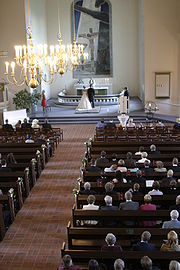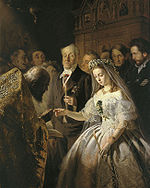
Marriage vows
Encyclopedia


Background
In secular ceremonies, vows can be chosen freely or created by the couple. Couples marrying within a religious tradition are often constrained to use the standard vows of that tradition's ceremony.Writing one's own vows
In some countries it is common for couples to write their own vows. Inspirations are often taken from poems, movies, or music. Vows usually consist of what characteristics each bring out in each other, what they look forward to in life, how their lives changed once they met. Vows tend to be between two and three minutes in length and are a public expression of love.Traditional Roman Catholic vows
Couples wedding in the Roman Catholic Church will essentially make the same pledge to one another. The customary text in English is:I, ____, take you, ____, to be my (husband/wife). I promise to be true to you in good times and in bad, in sickness and in health. I will love you and honor you all the days of my life.
The priest will then say aloud "You have declared your consent before the Church. May the Lord in his goodness strengthen your consent and fill you both with his blessings. That God has joined, men must not divide. Amen."
Marriage vows in England
The law in England authorises marriages to be legal if properly carried out and registered in the Church of England and some other religious bodies (e.g. Jews, Quakers): other men and women who wish to marry can be married by a local official authorised to do so (civil ceremony). Circumstances may result in the same partners having both ceremonies at different times though this is rare. The vows, presence of witnesses and civil registration are absolute requirements under the law.Civil ceremonies
Civil marriage
Civil marriage is marriage performed by a government official and not a religious organization.-History:Every country maintaining a population registry of its residents keeps track of marital status, and most countries believe that it is their responsibility to register married couples. Most...
often allow couples to choose their own marriage vows, although many civil marriage vows are adapted from the traditional vows, taken from the Book of Common Prayer
Book of Common Prayer
The Book of Common Prayer is the short title of a number of related prayer books used in the Anglican Communion, as well as by the Continuing Anglican, "Anglican realignment" and other Anglican churches. The original book, published in 1549 , in the reign of Edward VI, was a product of the English...
, "To have and to hold from this day forward, for better for worse, for richer for poorer, in sickness and in health, to love and to cherish, till death us do part."
They were first published in English in the prayer book of 1549, based on earlier Latin texts (the Sarum and York Rituals of the medieval period). An older version of the final phrase is "and to obey, until death us do depart" where "depart" means "separate". "Until death us do depart" had to be changed due to changes in the usage of "depart" in the Prayer Book of 1662
Book of Common Prayer
The Book of Common Prayer is the short title of a number of related prayer books used in the Anglican Communion, as well as by the Continuing Anglican, "Anglican realignment" and other Anglican churches. The original book, published in 1549 , in the reign of Edward VI, was a product of the English...
. In the 1928 prayer book (not authorised) and in editions of the 1662 prayer book printed thereafter "and to obey" was retained (in the 1928 book an alternative version omitted this). The 1928 revised form of Matrimony was quite widely adopted, though the form of 1662 was also widely used, though less so after the introduction of the Alternative Service Book
Alternative Service Book
The Alternative Service Book 1980 was the first complete prayer book produced by the Church of England since 1662. Its name derives from the fact that it was proposed not as a replacement for the Book of Common Prayer but merely as an alternative to it...
.
The original wedding vows, as printed in The Book of Common Prayer
Book of Common Prayer
The Book of Common Prayer is the short title of a number of related prayer books used in the Anglican Communion, as well as by the Continuing Anglican, "Anglican realignment" and other Anglican churches. The original book, published in 1549 , in the reign of Edward VI, was a product of the English...
, are:
Groom: I,____, take thee,_____, to my lawful wedded Wife, to have and to hold from this day forward, for better for worse, for richer for poorer, in sickness and in health, to love and to cherish, till death us do part, according to God's holy ordinance; and thereto I plight thee my troth.
Bride: I,_____, take thee,_____, to my lawful wedded Husband, to have and to hold from this day forward, for better for worse, for richer for poorer, in sickness and in health, to love, cherish, and to obeyObedienceThe term obedience can refer to:* Obedience ** The educational film Obedience about the Milgram experiment on obedience to authority figures* Vow of obedience as an evangelical counsel* Obedience training for dogs...
, till death us do part, according to God's holy ordinance; and thereto I give thee my troth.
Then, as the groom places the ring on the bride's finger, he says the following:
With this Ring I thee wed, with my body I thee worship, and with all my worldly goods I thee endow: In the name of the Father, and of the Son, and of the Holy Ghost. Amen.
In the Alternative Service Book (1980) two versions of the vows are included: the bride and groom must select one of the versions only. Version A:
I,N, take you, N, to be my wife (or husband), to have and to hold from this day forward, for better, for worse, for richer, for poorer, in sickness and in health, to love and to cherish, till death us do part, according to God's holy law, and this is my solemn vow.
Version B is identical except for the clause "to love and to cherish" where the groom says "to love, cherish, and worship" and the bride says "to love, cherish, and obey".
On September 12, 1922, the Episcopal Church voted to remove the word "obey" from the bride's section of wedding vows. Other churches of the Anglican Communion each have their own authorized prayer books which in general follow the vows described above though the details and languages used do vary.
Eastern Orthodox

Marriage in the Eastern Orthodox Church
-Introduction:The Sacrament or, more properly, Sacred Mystery of Marriage does not unite a man and a woman. Rather, it is the Church's recognition of a union that God has already begun to work in their lives. As long as the union remains within the reality of this world, it will be subject to sin,...
(wedding ceremony) of the Orthodox Church. However, the priest
Priest
A priest is a person authorized to perform the sacred rites of a religion, especially as a mediatory agent between humans and deities. They also have the authority or power to administer religious rites; in particular, rites of sacrifice to, and propitiation of, a deity or deities...
asks first the groom then the bride:
- Priest: Hast thou, [Name], a good, free, and unconstrained will and a firm intention to take unto thyself to wife (husband) this woman (man), [Name], whom thou seest here before thee?
- Groom (Bride): I have, reverend Father.
- Priest: Thou hast not promised thyself to any other bride (man)?
- Groom (Bride): I have not promised myself, reverend Father.
It should be noted that in the Byzantine Rite
Byzantine Rite
The Byzantine Rite, sometimes called the Rite of Constantinople or Constantinopolitan Rite is the liturgical rite used currently by all the Eastern Orthodox Churches, by the Greek Catholic Churches , and by the Protestant Ukrainian Lutheran Church...
, the rings are not exchanged during the wedding ceremony itself, but rather at the Betrothal. In current practice, however, the Betrothal is usually celebrated immediately before the Crowning.
Further reading
- Daniel, Evan (1948) The Prayer-Book; its history, language and contents; 26th ed. Redhill: Wells Gardner; pp. 491–96: The form of solemnization of matrimony

